textshow (4)
By:
December 17, 2018
Being the fourth in a quarterly series of passionate conversations from the cafeteria of pop-culture: textshow throws a variety of artistic observers into the arena of social media, to discuss movies, comics, TV and other artifacts of the collective media consciousness just waiting for some free association. Conducted in real-time, these threads are followed where they feel like, with the tangential revelations and composed spontaneity only this new media makes possible.

We create those we aspire to in our own image and those we look down on in our own imagination. Power, and superpower, conceded little in the centuries of ancient myth and modern archetypal fiction; many readers, viewers and believers couldn’t find the selves they wanted to see, while those in the majority (on each side of the screen or page) concentrated on the icons they expected they could be. Parallel to real-life human-rights pioneers fighting to even make it onto network or newsprint, Luke Cage was one of the earliest superhuman fantasy figures to break down the barrier, and has fought his way from two to three dimensions ever since.
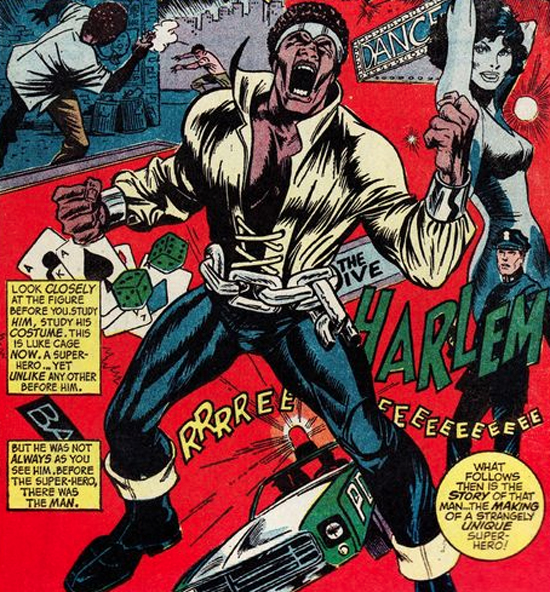
All things to all people except, perhaps, himself, Cage stands at a crossroads of White conception and Black subjectivity across many seasons of history. Outliving the Blaxploitation craze that created him, the gangsta clichés he was later sealed up in, and the obscurity he strangely suffered while often being the sole representative of his pop-culture kind, Cage conveys a reality as vivid as his activist and achiever models’ history is enduring; coexisting with them now in cultural memory, his meaning is just as contingent and contested.
The recent Netflix series (Jessica Jones season one; Luke Cage seasons one and two; and The Defenders) afforded as many viewpoints on him, and sparked as many interpretations, as the character has throughout his 46-year history; an exhibition at UC Riverside, “UnCaged: Hero for Higher,” records and re-envisions his proliferating significance for familiar, new and future observers alike.
The show is conceived and created by designer/scholars John Jennings and Stacey Robinson (collectively credited as “Black Kirby,” a persona and project intersecting Afrofuturist thought and vernacular culture concerns); I spoke with Jennings, Robinson, and sci-fi/social commentator and columnist Emily Asher-Perrin about cracking the codes of Cage, and considering how he has found his way into popular consciousness.
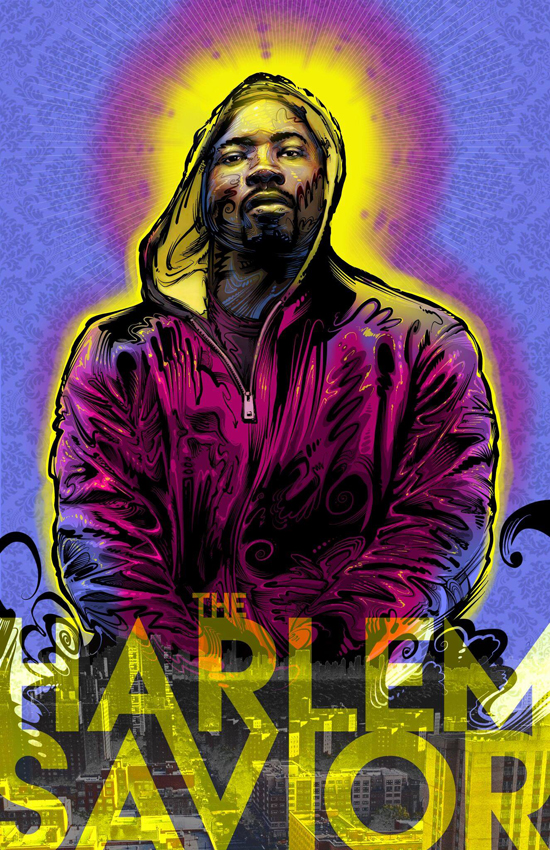
HILOBROW: Over the years since 1972, how much of the enjoyment of Luke has been guilty pleasure and how much is just loyalty to the potential he might one day fulfill — the real person that a reader knows is in there somewhere?
JENNINGS: I think like… 67.5% guilty pleasure? LOL
ROBINSON: I think it’s an amalgam of all those.
HILOBROW: What makes it worth it?
JENNINGS: To me, the potential of being seen as subject makes it worth it. It does upset me sometimes that so little attention is paid to Black subjectivity and cultural production.
ROBINSON: The books have never lived up to the potential of a character like that. The Netflix series humanized the character in a way the books have always failed to do.
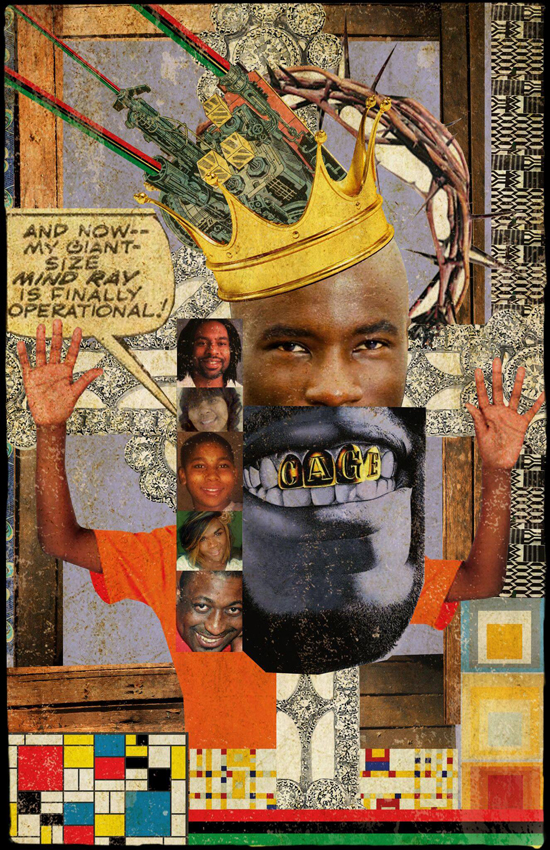
HILOBROW: He is uncommonly human-scale as superhumans go — tied to everyday justice issues, but on the other hand, issues that many readers (and publishers, and TV producers) might not want to deal with — is this a source of his endurance yet under-the-radar-ness?
JENNINGS: Perhaps, Adam. Most writers didn’t have the depth of knowledge to really make the character interesting and then there’s the editorial side of things… I think that I became a fan of Power Man aka Luke Cage more when he’s juxtaposed with his partner Danny.
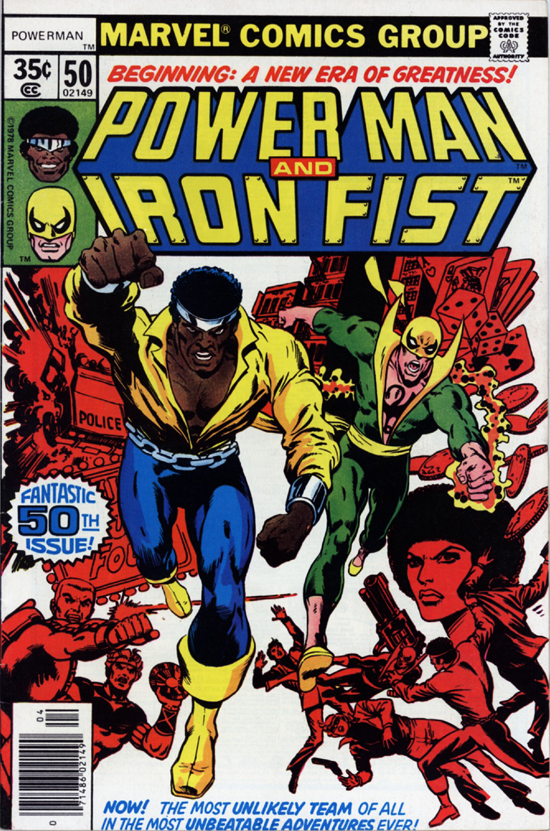
ASHER-PERRIN: It’s funny because I also always enjoyed Cage more when juxtaposed with Danny, and I think it’s because it’s harder to lean on tropes when he has someone to bounce off of.
ROBINSON: I actually think he became the most interesting in the books when he became team leader for the Avengers, shout-out to [Brian Michael] Bendis.
JENNINGS: Right. The fact that Bendis loves the character was a huge boon to how he gets uplifted to a grander scale. He becomes more of a hero when he has a family.
HILOBROW: I do have to make an exception for Bendis; he really gave Luke a voice that rang truer than ever before.
JENNINGS: He loves that character and you can tell he does.
ROBINSON: Family and humanness are interesting as character developments.
JENNINGS: Some of [Luke’s] best characterization is when [Bendis] was writing Daredevil and Luke is in there as his “bodyguard.”
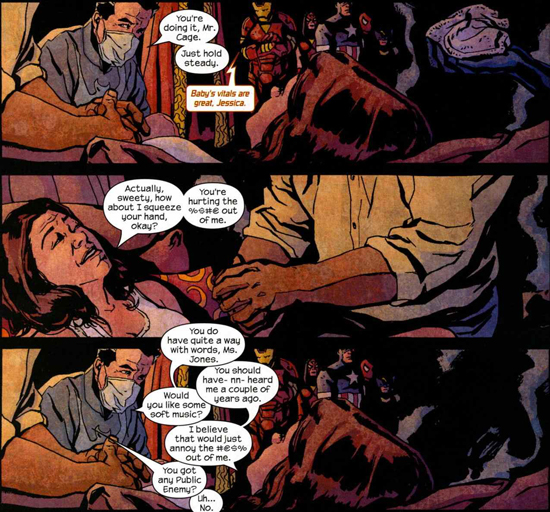
HILOBROW: I didn’t like most of Bendis’ Avengers but I saw Luke in the original Alias [Jessica Jones comic] as the turning-point for that character.
ROBINSON: I also have issues on how that’s addressed. Cage can only be seen as human when he’s coupled with a White woman. Before this he’s a thug and its various connotations.
ASHER-PERRIN: And also when he’s coupled with a White man, when you take Danny’s importance in his history.
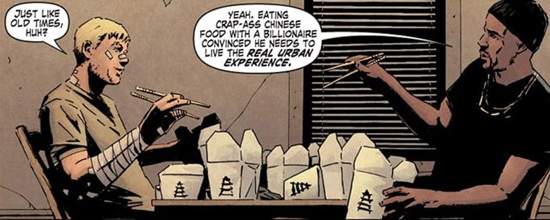
ROBINSON: Tony Isabella created Misty Knight in part as his love interest… but coupling him with a White woman, with a child, does a number of things; makes him safe for White fans, and then makes him [available] to future writers to deal with the character as a responsible Black man, to a White woman.
HILOBROW: Is that a reversal of old (perceived) transgressions @Stacey or another way of making him contingent on White characters’ personhood?
ROBINSON: Black heterosexual imaginings in comics are still real-world White fantastic threats. [But] I love Cage as a parent.
JENNINGS: I do too. He’s a great dad. And we need to see that more often. The myth about how Black men are unreliable fathers is a total lie… it’s propaganda about Black families that has persisted since slavery. So, for him to be shown as a caring, loving father meant a lot to me.
ASHER-PERRIN: While I understood that the show didn’t want to jump too far down the narrative pipeline, I really wanted to see the fatherly side of Cage on the show, and instead we get his rough relationship with his dad.
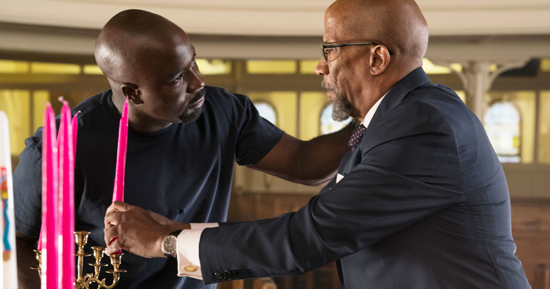
ROBINSON: Yesssssss. Reg E. Cathey’s character was great. I wanted to see that reconciliation. Black people don’t get that often on screen. But for White characters it’s the premise of every movie.
JENNINGS: The second season was so much better than the first one.
ASHER-PERRIN: So much better.
HILOBROW: “for him to be shown as a caring, loving father meant a lot to me” — yeah, in one of my written-down questions I was gonna ask if Cage is “Marvel’s Black friend,” ‘cuz he seems most to thrive in team books (Thunderbolts, Mighty Avengers, etc.) — but it is unusual for American mass culture to see him as a father figure, which he essentially is to those teams too.
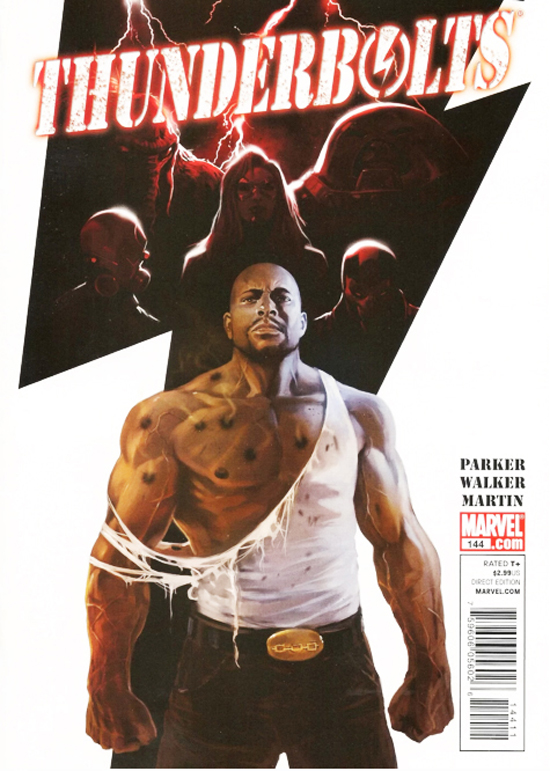
JENNINGS: That’s exactly right. In fact, our friend Stanford Carpenter once said to me that he felt that Luke Cage saw Danny Rand as a friend but Danny looks to Luke as a surrogate father figure and that’s why their relationship works.
ROBINSON: Wow.
HILOBROW: That’s fascinating about Danny — never thought about it, but he is, even at his best, the “junior partner” — come to that, with his money and resources, he’s also like an unfit father that Luke helps keep on more of a right track… The continuity of fatherhood was a feature I loved in each season of the TV show… from Pop to Reg E. Cathey…
ROBINSON: YES!!!!! As a Black man who never knew his father these moments are important to me… as a father of both a son and a daughter.
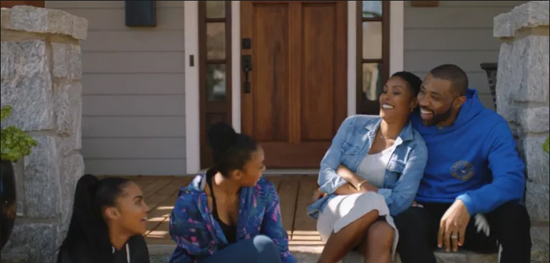
JENNINGS: When Black showrunners get their hands on Black characters… like Luke Cage or Black Lightning… the humanity becomes so apparent.
HILOBROW: What about the compromises? Black readers always had to compartmentalize their thrill at seeing a character like Luke get top-billed at all, with the embarrassment of his caricature; in the same way I got this uneasy feeling in the first Black Lightning eps of there being real talk I hadn’t seen on TV, but also these odd narratives of Black self-destruction and culpability, i.e., “gangs” being more of a problem than an unleashed policed force…
JENNINGS: That’s true, Adam. Sometimes, we have to have very loving critiques of the representations. On one hand, you get these very wrong assumptions about what’s happening in these inner city spaces in Black Lightning but, then you get to see a happy functioning Black family in total too.
ASHER-PERRIN: The shows keep getting cancelled, and my biggest worry is that the Defenders group will show up in other Marvel shows on Disney+ with all these arcs completed, and we’ll never see how they got there.
JENNINGS: One of the things that bothers me the most about these corporate narratives is that capitalism totally upends the natural flow of plot and story… They don’t care about how stories function. Only profit. So, they totally disrupt character development, flow, story logic, continuity etc. because of other deals etc. that have nothing to do with how the characters should actually react. Then you layer race, gender and class issues on top of that? You have a lot of bad storytelling LOL
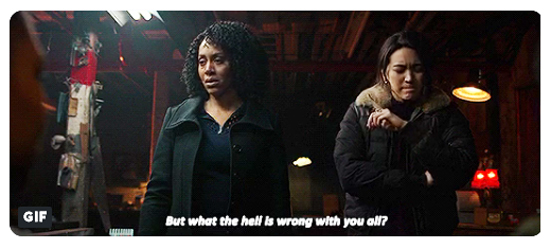
ASHER-PERRIN: It’s very true, which is why you end up with the amazing Daughters of the Dragon lead-in on Iron Fist, and then the show gets cancelled immediately afterward.
ROBINSON: Yes Emily. They teased DotD and here honestly is where I wanted to see Claire [Temple, partner and nurse to the powered community]. I was so frustrated with her popping up out of everywhere as a main character. It made no sense for the story, to put a civilian in danger.
ASHER-PERRIN: Me too, omg, Claire deserved her own space.
ROBINSON: DotD was the perfect setting for her. Yes.
HILOBROW: If Disney is smart, they should start over with a DotD show, a Power Man/Iron Fist show and a Night Nurse… that would be picking up where Netflix left off. As to corporate necessities overriding story [and the background arcs disappearing], I think binge-canons endure these days in a way that won’t make that a problem.
ROBINSON: We all live in the White fantastic, when reading these books… It’s limiting to the potential. Black folks take these ideas very seriously even as comics.
JENNINGS: True, Stacey… and until we get a true spectrum of Black experiences then we always will.
ROBINSON: We love fantasy too.
HILOBROW: Exactly @Stacey — fantasy is urgent, because people from different vantage points won’t necessarily agree on what’s reality.
ROBINSON: Black Lightning, Black Panther, Luke Cage, are not simple entertainment to us.
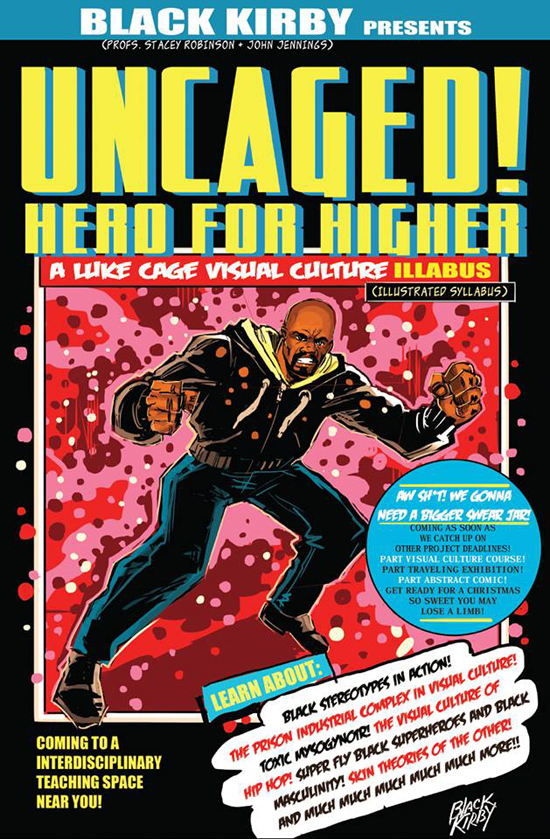
ASHER-PERRIN: I recently saw a tweet over on Twitter where someone made the point that White people get so much media that we’re allowed to critique it. Because when you have an abundance of story, you don’t feel obligated to sing the praises of all of it. And I feel like that plays into the “guilty pleasure” problem of characters like Luke Cage.
ROBINSON: I love Black women and made two beautiful Black children with one. Ironically Christina Adams (Lynn from Black Lightning) looks like my ex-wife. Those images of reconciliation, compromise, growth, etc. mean a lot to us. White readers, viewers have no idea what it’s like to live outside of their desired narratives. They can concentrate on building nuance in film, literature, etc. … why? Because their narratives aren’t blocked by racist distribution systems.
JENNINGS: I do think that fans have a lot more input on this stuff now too. Companies are paying attention to what folks are wanting… unless I am delusional.
ASHER-PERRIN: I do think the companies are starting to pay attention to the full fanbase more often these days, but there are certain lines they won’t cross yet (i.e., queer representation).
HILOBROW: @Emily the fan input can be a double-edged sword too… fanboys and fangirls can be as doctrinaire as corporate masters are deterministic…
ASHER-PERRIN: Sometimes the fans are even worse than the exec room! It’s definitely not always a good thing.
ROBINSON: No delusions @John. Yup fans are shifting ideas. That’s why BP and Storm’s marriage was annulled. And soon after Storm was written to have slept with Wolverine. The idea of Black heteronormal destroys White fantasy. Thus Luke Cage can be with Misty for a night… but with Jessica Jones forever…
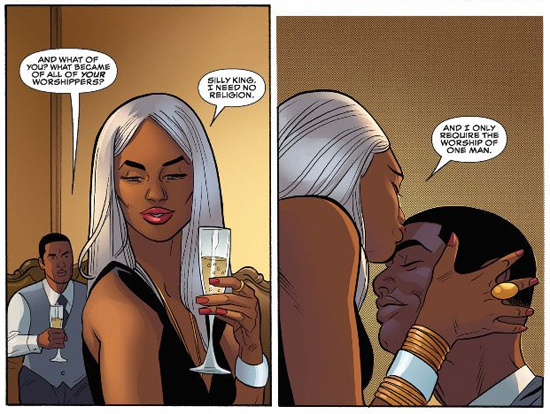
HILOBROW: I always looked askance at that Black Panther/Storm marriage… seemed like a central-casting thing dreamed up in a White boardroom… though I loved them together in Dwayne [MacDuffie]’s Fantastic Four, and their relationship in [Ta-Nehisi] Coates’ Panther book is one of the most mature of any comic characters I’ve ever seen…
ROBINSON: “I always looked askance at that Black Panther /Storm marriage… seemed like a central-casting thing dreamed up in a White boardroom” — Lots of folks say that. I imagine so. But why is it so unimaginable????? That’s the much larger question about how we see race.
HILOBROW: @Stacey this is a discussion we began at the Black Comic Fest ’17… the “taboo” used to be seeing a White and Black character in a relationship, but I see your point about there having to be a White person in the mix and that taking precedence since Whites are so allergic to ever not seeing their face up there. (In any case, Coates has totally won me over to BP & Storm’s healthy, happy divorce :-).)
JENNINGS: LOL “allergic”
ASHER-PERRIN: To be fair, I buy Storm/BP a lot more than I ever bought Storm/Thor?
ROBINSON: Black, African, Power, deity [elements] exist in both Storm and BP… it’s casting and logical… who else in the MU would understand each other? White male power fantasy; they wanna have sex with Storm.
JENNINGS: No Stacey. It’s obvious that Storm would TOTALLY go for hairy little Logan!!
HILOBROW: 😂
What did y’all like better overall about Luke season 2? I thought the entire portrayal of the Caribbean community was superficial and caricatured (notwithstanding Bushmaster’s blazing charisma and conviction)… or is that in the “forgiving criticism” column?
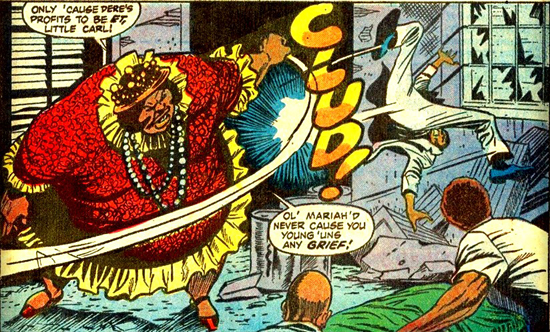
JENNINGS: I think that they did a great job of taking VERY, VERY, VERRYYYY stereotyped comic book representations and actually made them into actual characters. Like Big Ben Donovan becoming this insidious lawyer. How they used Cockroach and Piranha Jones. Especially how they took a villain that was an evil “mammy” character [“Black Mariah”] and gave her a powerful story arc and made her into one of the most compelling Black female characters I’ve ever seen. Especially in a comic book superhero story. As for the superficial ideas around the culture… at least they tried to represent these ideas on screen. The notion that ancient root work is equal to “modern science” is something that I deal with in my own creations. I know the accents were off and there were corners cut but they at least wanted to take that journey.
ROBINSON: I love the flip of the horrible characters.
HILOBROW: Fair enough @John — I too loved how they’ve fleshed out Piranha, Big Ben, Mariah et al. — though that was all season 1… but I see your points about season 2’s intentions. [Fact-check: Cockroach Hamilton and Piranha Jones were each introduced in season 2, so this argument starts to crumble. — Adam]
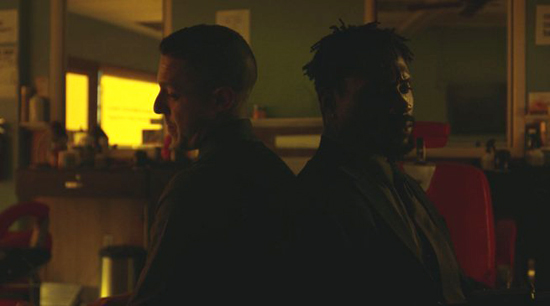
JENNINGS: And the triangle between Mariah, Shades and Comanche? Wow.
ASHER-PERRIN: That triangle broke my damn heart and I’ve still not recovered.
ROBINSON: Shades and Comanche and Mariah… yes
HILOBROW: The Shades/Comanche arc was a masterpiece… ep 6 was the only one of that season that I fully loved.
JENNINGS: I loved that.
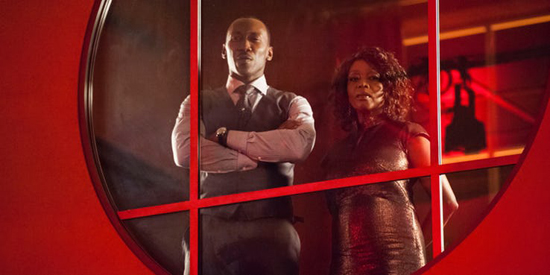
JENNINGS: The main issue with season one was the ending as well. After Cottonmouth dies, it doesn’t know what to do.
ASHER-PERRIN: It’s so strange because I’ve read interviews where [showrunner Cheo Hodari] Coker claimed that his intention with Cottonmouth was to pull a “Psycho,” taking a big league star, make the audience think he was the big lead, and then just snatching him away. And I love the idea of doing that here, but it really killed the season’s momentum (partly because Diamondback just didn’t work).
HILOBROW: [Mahershala] Ali was so amazing that I found it gutsy for us to be robbed of him mid-season…
JENNINGS: @Emily Asher-Perrin yes. Diamondback was a terrible “big bad” ugh. It became a bad ’80s film at the end. And [Luke] STILL has to go to prison???
ASHER-PERRIN: He still has to go to prison after the guy fighting him has military-grade tech from Justin Hammer somehow???
HILOBROW: I felt that was def how it would go down for a Black superhero.
JENNINGS: And there you have it.
ASHER-PERRIN: Very true.
ROBINSON: He did get coffee first tho…
JENNINGS: So, one big issue with the both seasons though is that they never give us the Luke Cage we see in the comics. Like why is he NOT the Hero for Hire???
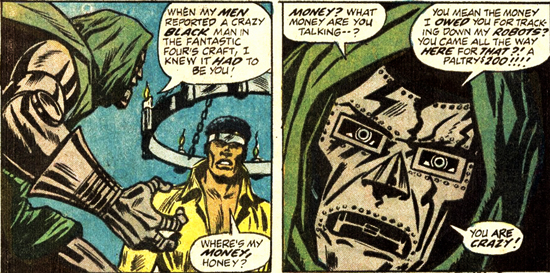
ASHER-PERRIN: I do wish that we had seen the “Hero For Hire” dynamic played out on the show because I wanted to see how the world reacted to that. What do people in the MCU think about needing to pay for someone’s help, and can we have a conversation about [how] people need to get paid for their work in a world where everything is an unpaid internship?
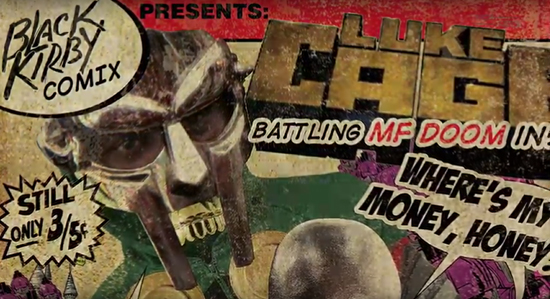
ROBINSON: I love the hero for hire idea… makes sense to me.
JENNINGS: Exactly @Emily Asher-Perrin. Think about Cage being a detective show like Jessica Jones.
ROBINSON: We kind of do though, he’s a detective in both seasons serving the community.
JENNINGS: I guess? But he’s more of a bodyguard of Harlem. He’s based on Shaft a bit. Let him be Shaft with powers LOL. The economic issues about what it would actually mean to be a Black man with superpowers who is an ex-con.
ROBINSON: Yes. I wanna see that.
JENNINGS: Luke Cage in the comics would not be sweeping floors unless it’s with bad guys FOR MONEY LOL
ROBINSON: Peter Parker is a hustler, Spider-Man makes money fighting the Lizard and sells pics… He’s a freelancer in mid-air.
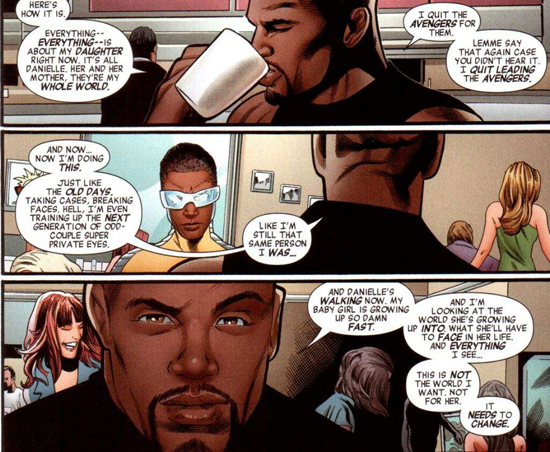
HILOBROW: @John, that was the one thing I thought [the comics’ early-Aughts gangsta version by Brian] Azzarello got right — the fact that Luke went back to being a businessman, of necessity and relatively without judgment. Though I also like his nonprofit benefactor role in Al Ewing’s Mighty Avengers… he’s not just a father but a wise big brother.
ASHER-PERRIN: Ewing is another one who often brings out the humanity in characters who aren’t always given it.
HILOBROW: So true @Emily — does anyone but me get the impression that White writers who didn’t grow up in America understand the Black voice better than most American White writers?
JENNINGS: That actually may be a good point. Ales Kot for instance.
ASHER-PERRIN: Yeah, I agree — maybe because they haven’t spent their lives mired in America’s specific brand of racism?
JENNINGS: I need to go back and read The Mighty Avengers and The Ultimates.
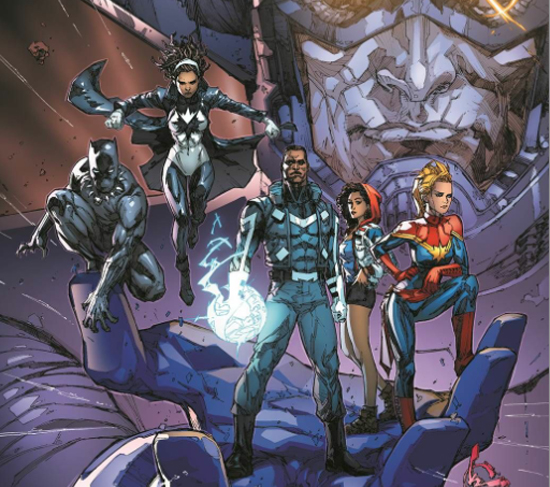
HILOBROW: @John, Ewing’s Ultimates was a rare phenomenon — a majority-POC and majority-female team book that ran three times as long as Priest’s The Crew… wonder if it was because it was not billed as a “diverse” book?
JENNINGS: Maybe so. I was enjoying it but I just got busy lol. Too many things to read, watch along with making this work.
ROBINSON: I gotta catch up on so many of the books. Lots of great things happening. But we take our images, whether made by us or not, seriously… and we actually live the characters, they are just as real to us as for White folks.
HILOBROW: @Stacey, these characters are real to those they represent, and to all us hardcore nerds — but many who come to your show may not know Luke as a household word like we do — how do you invite their interest/investment?
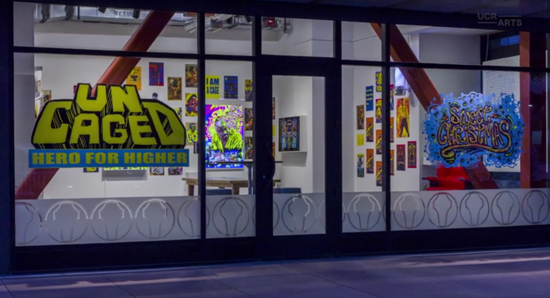
JENNINGS: Well. Hopefully the work is visually attractive enough. We’re designers and we put together a visually engaging show. The gallery director has been saying that people actually press their faces against the windows to see what’s going on. The show is actually an “illustrated syllabus.” We have our book list installed in the space, and we actually have ten prompts for a quarter-long class. So, it’s made to teach people about the character and at the same time… learn about Black history.
ROBINSON: It’s hip-hop, by our imagining of him, what we do with the character… he’s Shaft and John Henry and the ultimate baddass song.
JENNINGS: Luke Cage, because of some of the underdevelopment of the character by some writers, is a very open symbol that we see as an index for Black history. He’s from the South so he becomes an index for the Great Migration. He’s an ex-con and becomes an index for the prison industrial complex. He’s experimented on and becomes and index for medical apartheid. You can actually teach a Black history class just with Luke Cage as a filter.
HILOBROW: So true. In any given decade you can tell how Whites are conceiving of (not necessarily knowing) Black people, and how Black voices are replying and amending, by how Luke is portrayed.
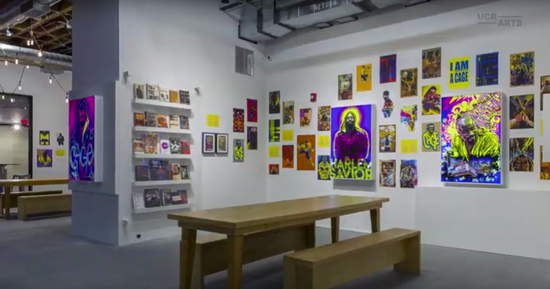
ROBINSON: It’s also an open-source exhibition, you have to bring in your ideas to even converse with the materials.
JENNINGS: But you HAVE to know the history… AMERICAN history about how Black people have had to survive in this country.
HILOBROW: Rather than reboots, Luke has reacted with the times — more a maturation than a retcon. Is there any other example? (Maybe Captain America, perhaps not uncoincidentally now written by Ta-Nehisi…)
JENNINGS: Maybe Batman?
HILOBROW: I don’t think Batman @John, he has been restarted many times… whereas Luke just seems to take on more layers (moved-up timelines notwithstanding :-))
JENNINGS: Essentially the show is a form study of Luke Cage. Form studies are used by designers to show possible design solutions through hacking into the form and exposing it to remixes and re-juxtapositions:
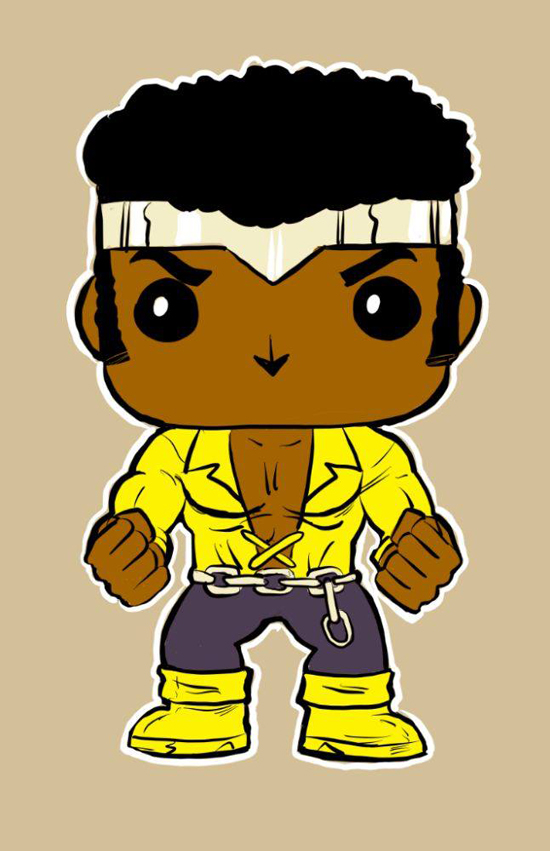
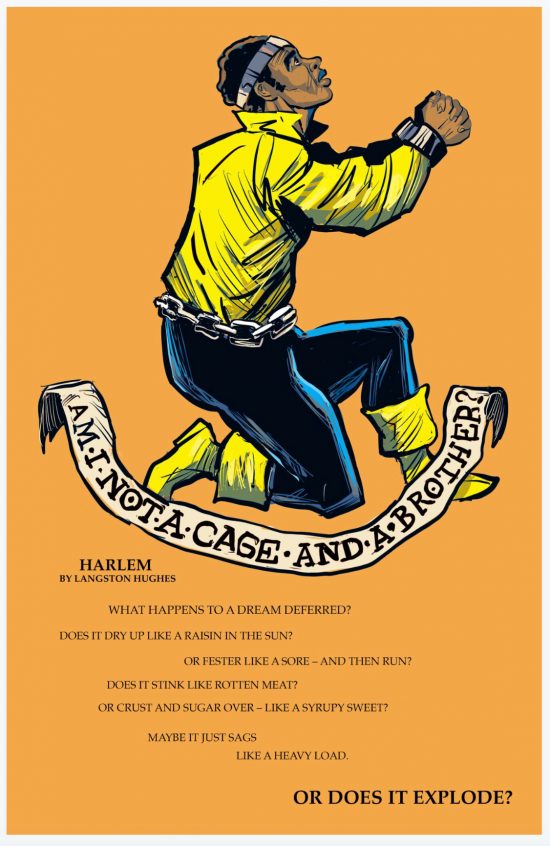
HILOBROW: I like the contingency yet comprehensiveness of the form study idea @John — we’ve talked a lot here about identities that morph with perspectives, both subjective and exterior…
JENNINGS: Yes. Form and content.
Another driving force for the work we do is this construct we developed called CRITICAL RACE DESIGN STUDIES:
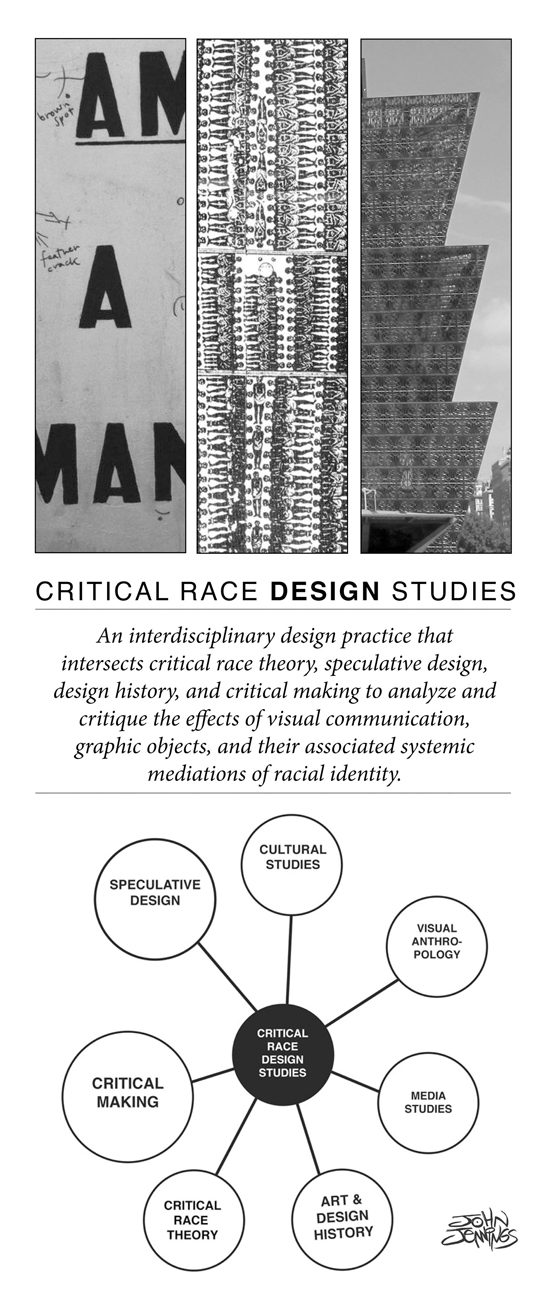
ROBINSON: What’s interesting is that all those form studies are the Black existence. Us always proving our humanity. And pleading to be seen as human.
HILOBROW: Before “superhuman” can even be considered…
JENNINGS: Yes. There’s a piece I did that deals with that. When Luke Cage first gets his powers he states that “he’s not even human anymore.”
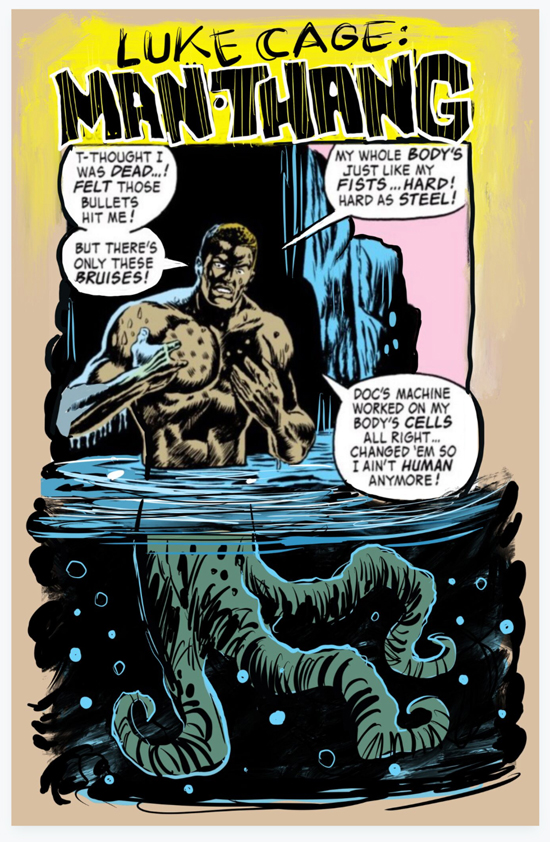
ROBINSON: I talk about that in the exhibition too:
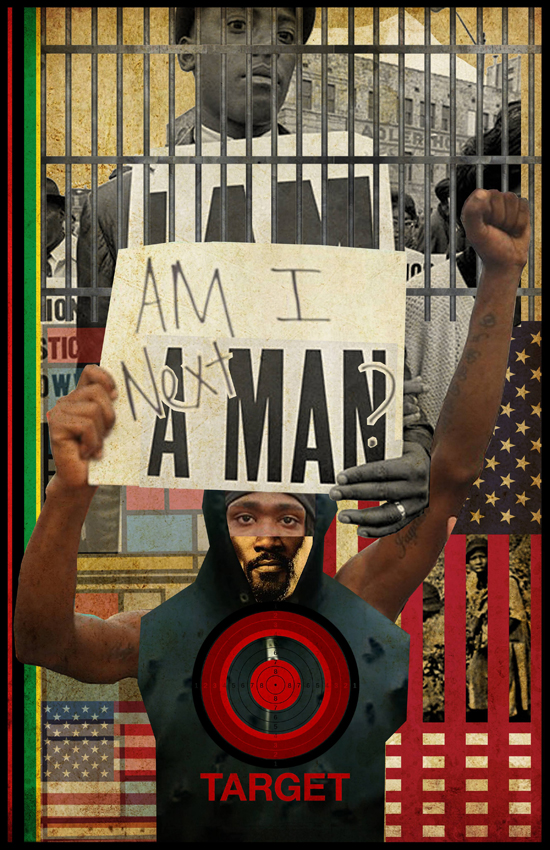
HILOBROW: Not sure if he was the first who said it, but my teacher Christopher Cozier (the Trinidadian visual artist and thinker) had a piece where he talked about “fighting to be a reality and not a reference.”
JENNINGS: Exactly.
ROBINSON: Am I next a man? I’ve been, nigger, negro, colored, Afro American, African American… can I be next a man… or human. Hu-man.
JENNINGS: So, in the Netflix show… each episode is named for a hip-hop song title. One artist per season I think. Season one is Gang Starr. Season two is Pete Rock and CL Smoove. So, our show has a ten-song Mos Def playlist on Spotify to go with the weeks of a course. You can find it by searching UNCAGED: ILLABUS BY MOS DEF.
ASHER-PERRIN: There was also a great piece by Tara Betts over on Black Nerd Problems where she cited every book Luke reads in S1 for a teaching syllabus on Black history, it’s really great.
HILOBROW: I loved all of Luke’s literary Easter eggs on the Netflix show.
ROBINSON: 😲
Need this
ASHER-PERRIN: Found it!
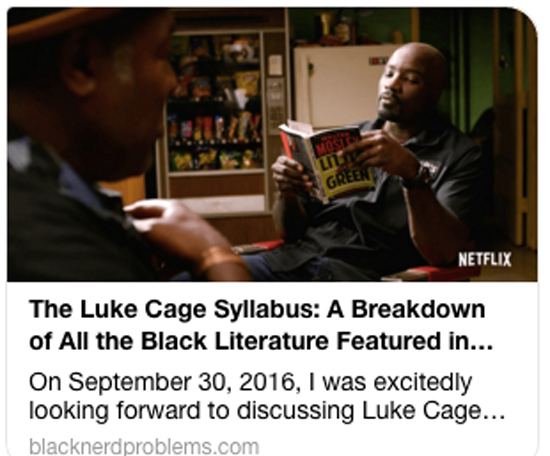
ROBINSON: Thanks @Emily Asher-Perrin
Posted
JENNINGS: OK cool. Did you all see this?
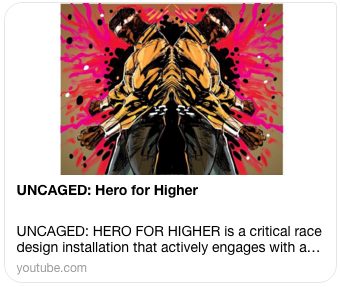
ASHER-PERRIN: Oh, wow! This makes me feel slightly less sad that I’m not close enough to drop in and see it
HILOBROW: Are people at your show surprised to learn of Luke’s existence? And is it empowering or bemusing?
JENNINGS: I think some are? We often forget that “mainstream” comics as a publishing form are quite the opposite.
ROBINSON: I think most folks know who LC is. You don’t come to the exhibition without having some insight.
JENNINGS: Some folks have never read a comic book before and are just as surprised that they still exist.
ROBINSON: I’m thinking at least through the Netflix series. Most folks don’t read comics.
JENNINGS: So even the idea of a Black superhero is totally foreign to them.
HILOBROW: I guess my question is a bit obsolete — Luke is a survivor of ’70s culture, not a relic.
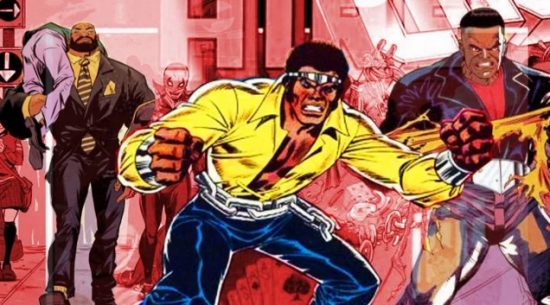
JENNINGS: Even Michael B. Jordan thought that there weren’t any other Black superheroes.
ROBINSON: bruh, come on. -_______-
JENNINGS: But, if you don’t come up reading them… how are you to know?
ROBINSON: But see that’s why what we do is important. Most folks aren’t scholars like that.
JENNINGS: Being a famous (blank) is like being a famous dentist LOL
ASHER-PERRIN: It’s true, I work with a lot of book nerds, and even among those groups there are so many people who don’t even touch comics.
ROBINSON: RIGHT!!!! It’s a different level of scholarship.
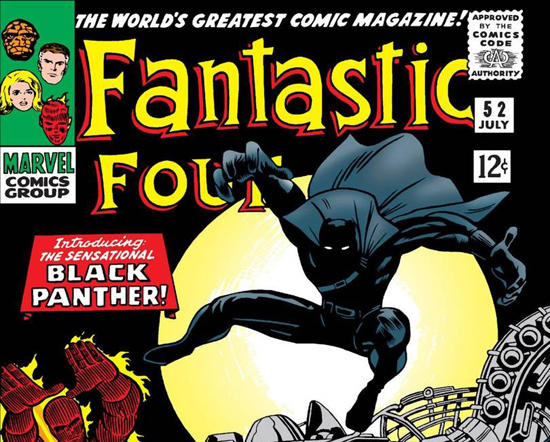
HILOBROW: I’ve gotten the impression that many people now are aware of the comics’ canon and waiting expectantly for certain concepts and characters to show up in the movies (I would hear strangers on the street getting excited about T’Challa’s debut) — but not actually ever going to the comics.
ROBINSON: Yes, it’s a different medium. I’m ok with that also. For me it’s about what inspires us.
HILOBROW: Yup — these viewers I know and overhear sound like I did when the 7-Eleven was about to get the new comics…
ROBINSON: YES.
HILOBROW: Do you see the gallery as closer to the comic-reading or screen-viewing experience @Stacey?
ROBINSON: They love the screen viewing. [These] are also different vehicles of storytelling with different affordances.
ASHER-PERRIN: I used to listen in the theaters when people would leave Marvel films, and see who was relying on their BFF who reads comics to fill in the gaps, and I do honestly love that dynamic among fans and friends.
HILOBROW: LOL yes @Emily I am the designated pulp-archivist many a time 😀
ROBINSON: Me too lololololo I love that. I used to have to answer folks. I did that after Iron Man 3. Kids behind John and I didn’t get the awesomeness of Tony talking to Bruce about his problems like a therapist… I loved when he said that he didn’t have the temperament. I fell out. He could actually Hulk out from having to listen to Tony’s narcissism.
ASHER-PERRIN: 😆
HILOBROW: 😆
This is late in the game, but your image above @John reminds me — it was interesting to see how Noah Burstein was re-characterized in the Netflix show — the benevolent Tuskegee vivisectionist of the comics always made me queasy…
ROBINSON: Adam:
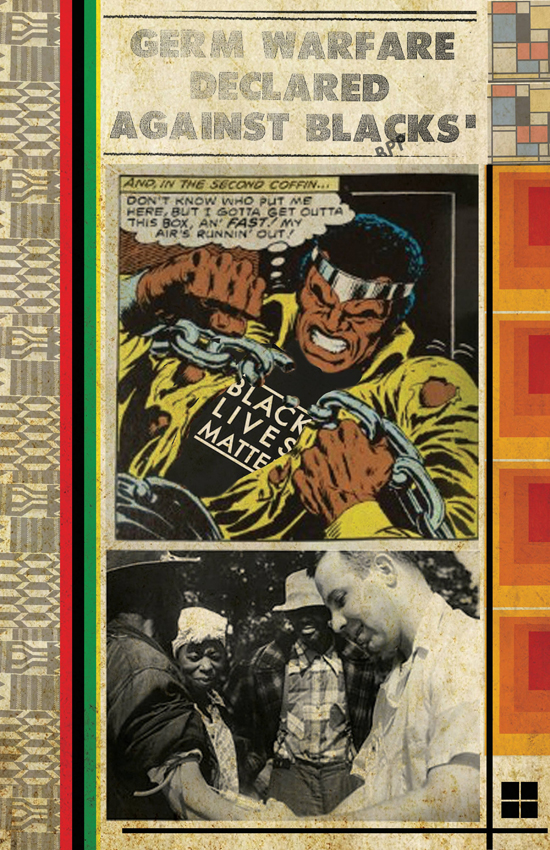
HILOBROW: @Stacey what do you make of Luke Cage #1 slightly predating the Tuskegee revelations? Or was it already common knowledge (or at least educated suspicion) in the communities of color? (I really liked it in Truth when the FBI guy tells Cap that Black folks have known about Isaiah Bradley [Cap’s experimental prototype] all along.)
ROBINSON: Exactly. We see it every day…downtown easily becomes a militarized test subject of the rest of America. I always tell White folks to watch what’s happening in Black America… it will affect them later.
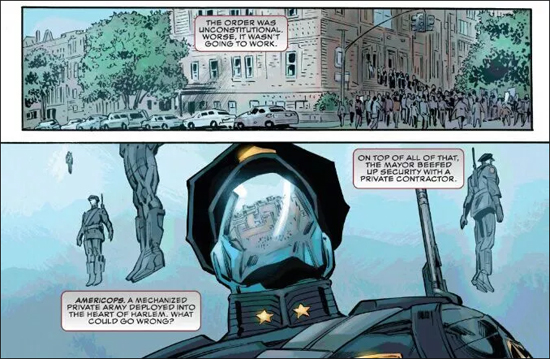
HILOBROW: (come to that, Black Panther and the Crew directly addressed that militarized state of existence @Stacey — only slightly fantasized…)
‘nother question that just occurred to me… what is your view of characters so malleable that they can seem like different incarnations simultaneously and not just across eras? I’m thinking of the really formal Luke in David Walker’s solo Cage book, and Yona Harvey’s more hip-hop version in Black Panther and the Crew…
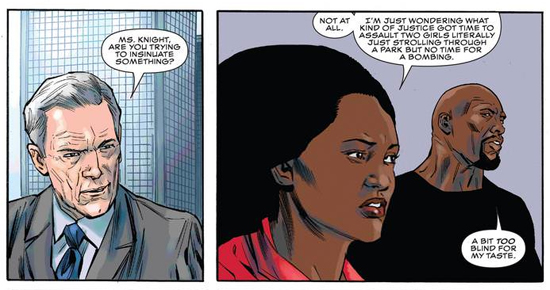
JENNINGS: I wonder if that’s more the mark of a good writer? To take a character and meld them to what’s necessary for the story? Or is it an amalgam of both?
ROBINSON: We have to be all these things at once. And don’t have the time to not be.
JENNINGS: As Langston Hughes said “Black is, and black ain’t” — both are true.
HILOBROW: Yeah, I was gonna say it’s like code-switching by the writer rather than the character… but interaction is character to a large extent, especially in open-ended franchise narratives… and yes, in real life, for those who a dominant class sees as just a story…
ROBINSON: That’s why we take this so seriously, why we are critical and celebratory of all Black pop culture.
HILOBROW: Which are the ingredients of true love.
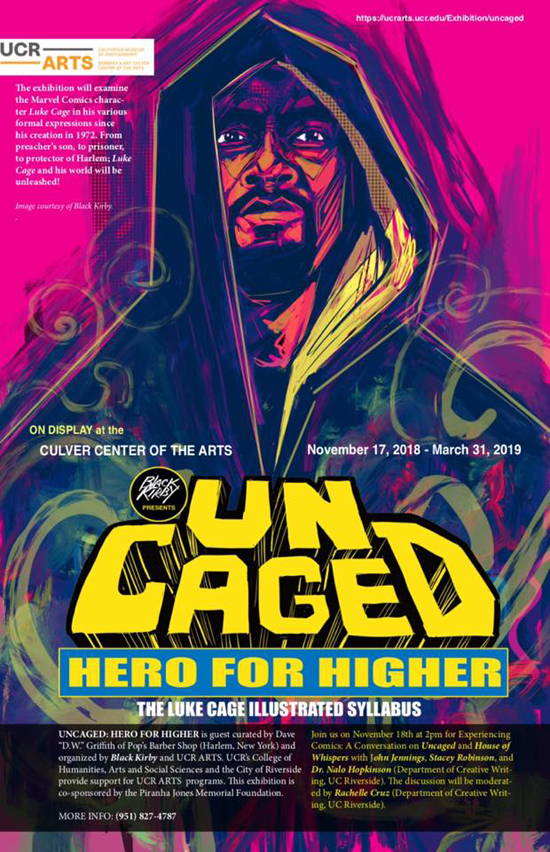
JENNINGS: I am also very much about using stories to unmake other stories. Like race for instance.
ASHER-PERRIN: “using stories to unmake other stories” yes, this, every day.
HILOBROW: Could be the most useful antidote @John
JENNINGS: Luke Cage is problematic but, the problems need to be dealt with. It’s that simple.
HILOBROW: Well said.
JENNINGS: I am glad that UCR is in support of Black Kirby dealing with this. In fact, they’ve greenlit two more shows back to back.
ROBINSON: Yes they did, and want to launch an exhibition every year.
HILOBROW: Do you know what the next ones will be?
JENNINGS: The next one will be Sept 29th, the subject is CANDYMAN.
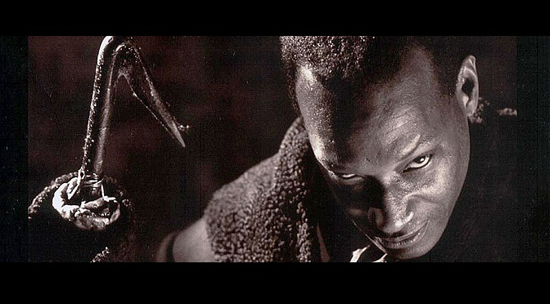
ASHER-PERRIN: niiiice
JENNINGS: btw, this was in the works before Jordan Peele’s announcement of the new remake.
HILOBROW: The zeitgeist is always in the room, @John 😀. And now that you’ve mentioned an “ethno-gothic“-themed show, I need you to stay here for two more hours to discuss Brother Voodoo! KIDDING.
JENNINGS: Yeah, we do! LOL But, we can discuss that another time. We’re doing a gallery talk this evening at 630pm. Wish us luck.
HILOBROW: Good luck! Break a tiara!
ASHER-PERRIN: Good luck!
JENNINGS: I like to think of it as a crown 😀
HILOBROW: 😀 Thanks so much everyone! And to all a Sweet Christmas!
Images, top to bottom: From the first page of Luke’s life; Black Kirby, from the “UnCaged” show; Black Kirby, from the “UnCaged” show; Luke & Danny’s first headline teamup; Luke & Jessica’s first kid, from The Pulse; Luke & Danny years later, from Alias; Colter & Cathey, from Luke Cage season 2; Cage takes command; Black Lightning and family; Netflix’s Misty & Colleen; “UnCaged” prototype poster; T’Challa & Storm, from Ta-Nehisi Coates and Chris Sprouse’s Black Panther; a vintage Black Mariah image; Netflix’s Shades & Comanche; Netflix’s “Cottonmouth” and Mariah; vintage Cage v. Doctor Doom; Black Kirby’s reinterpretation; Al Ewing & Greg Land’s Luke-led Mighty Avengers; Ewing and Kenneth Rocafort’s Ultimates; “UnCaged” exterior shot; “UnCaged” interior shot; Black Kirby, from the “UnCaged” show; Black Kirby, from the “UnCaged” show; Jennings’ definitions and diagrams; Black Kirby, from the “UnCaged” show; Black Kirby, from the “UnCaged” show; two link previews; Cage through the ages (some of them); Black Panther’s first appearance in print (art: Jack Kirby); Black Kirby, from the “UnCaged” show; two excerpts from Black Panther and The Crew by Yona Harvey & Ta-Nehisi Coates (script) and Butch Guice (art); official “UnCaged” poster; still from the original Candyman film.
textshow logo designed by Steve Price
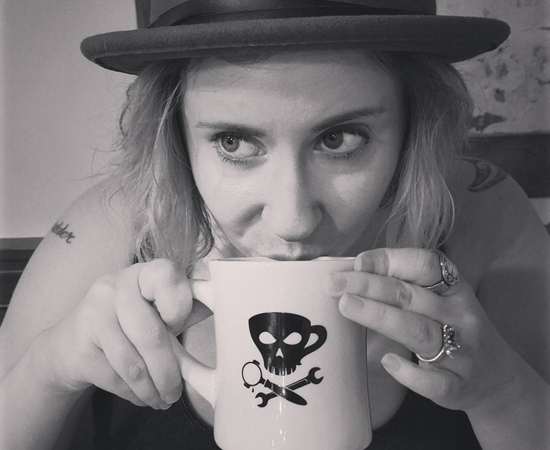
Emily Asher-Perrin is the senior staff writer for Tor.com, and has been a critic and commentator on sci-fi and fantasy pop culture happenings for the better part of a decade. With an eye often turned toward QUILTBAG and gender analysis, Emily’s essays and thoughts have showed up in Vulture, Queers Dig Time Lords, Outside In Star Trek, and podcasts such as Geeks Guide to the Galaxy and Imaginary Worlds.
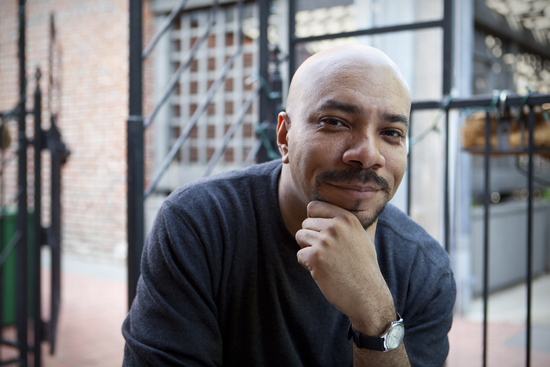
John Jennings is Professor of Media and Cultural Studies and a Cooperating Faculty Member in the Department of Creative Writing at the University of California, Riverside. His work centers around intersectional narratives regarding identity politics and popular media. Jennings is co-editor of the Eisner Award-winning essay collection The Blacker the Ink: Constructions of Black Identity in Comics and Sequential Art and co-founder/organizer of The Schomburg Center’s Black Comic Book Festival in Harlem. He is co-founder and organizer of the MLK NorCal’s Black Comix Arts Festival in San Francisco and also SOL-CON: The Brown and Black Comix Expo at the Ohio State University. Jennings sits on the editorial advisory boards for The Black Scholar and the new Ohio State Press imprint New Suns: Race, Gender and Sexuality in the Speculative. He is currently the Nasir Jones Hiphop Fellow at the Hutchins Center, Harvard University.
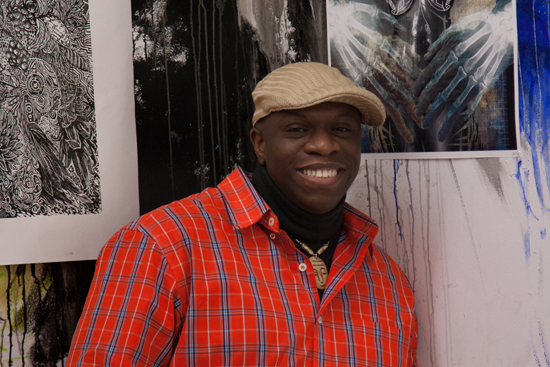
Stacey Robinson is an Assistant Professor teaching graphic design and illustration at the University of Illinois at Urbana Champaign and is an Arthur Schomburg fellow who completed his Masters of Fine Art at the University at Buffalo. His work discusses ideas of “Black Utopias” as spaces of conflict resolution away from colonial influence by considering Black affluent self-sustaining communities, Black protest movements and the art movements that document(ed) them.
As part of the collaborative team Black Kirby with artist John Jennings, he creates graphic novels, gallery exhibitions, and lectures that deconstruct the work of artist Jack Kirby to re-imagine Black resistance spaces inspired by Hip Hop, religion, the arts, and sciences. With MotherBoxx Studios, (a design team facilitated by Black Kirby), the duo collaborates with an amalgam of artists and writers to facilitate graphic novels, comic conventions, and curated exhibitions.
His recent exhibition “Binary ConScience” explores ideas of W.E. B. Du Bois’ “double consciousness” as a Black cultural adaptation and a means of colonial survival. Recent works: Kid Code: Channel Zero from Rosarium Publishing, Prison Industrial Complex for Beginners from For Beginners Books, and I Am Alfonso Jones from Tu Books.
MORE COMICS-RELATED SERIES: Douglas Wolk’s LIMERICKANIA | KIRB YOUR ENTHUSIASM — 25 writers on 25 Jack Kirby panels | ANNOTATED GIF — Kerry Callen brings comic book covers to life | COMICALLY VINTAGE — that’s-what-she-said vintage comic panels | DC — THE NEW 52 — an 11-year-old reviews DC’s new lineup | SECRET PANEL — Silver Age comics’ double entendres | SKRULLICISM — they lurk among us | Douglas Wolk’s THAT’S GREAT MARVEL, TAKING LIBERTIES, STERANKOISMS, MARVEL vs. MUSEUM, LIMERICKANIA, WTC WTF
MORE POSTS by ADAM McGOVERN: OFF-TOPIC (2019–2025 monthly) | textshow (2018 quarterly) | PANEL ZERO (comics-related Q&As, 2018 monthly) | THIS: (2016–2017 weekly) | PEOPLE YOU MEET IN HELL, a 5-part series about characters in McGovern’s and Paolo Leandri’s comic Nightworld | Two IDORU JONES comics by McGovern and Paolo Leandri | BOWIEOLOGY: Celebrating 50 years of Bowie | ODD ABSURDUM: How Felix invented the 21st century self | CROM YOUR ENTHUSIASM: C.L. Moore’s JIREL OF JOIRY stories | KERN YOUR ENTHUSIASM: Data 70 | HERC YOUR ENTHUSIASM: “Freedom” | KIRK YOUR ENTHUSIASM: Captain Camelot | KIRB YOUR ENTHUSIASM: Full Fathom Five | A 5-part series on Jack Kirby’s Fourth World mythos | Reviews of Annie Nocenti’s comics Katana, Catwoman, Klarion, and Green Arrow | The curated series FANCHILD | To see all of Adam’s posts, including HiLo Hero items on Lilli Carré, Judy Garland, Wally Wood, and others: CLICK HERE
